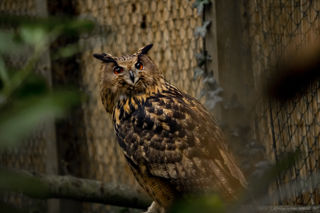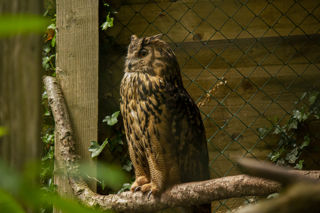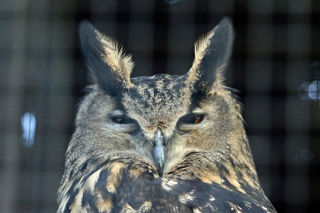
Eurasian Eagle Owl
Bubo bubo
Eagle owls are one of the largest owls, weighing up to 4.6kg and with a wingspan of 131-188cm. Females are larger on average than the males, although that’s the only real external difference between the sexes. Plumage of the upper parts can be brown and black to tawny and pale grey. They have distinctive ear tufts and orange eyes.

Twilight & Eclipse
Our two resident owls are Twilight and Eclipse. They have lived at the park for many years. Twilight was hatched in 1991 and Eclipse in 2007. You can see them high up on their perches, amongst the branches and natural camouflage. As with other owls, they are unable to move their eyes from side to side like humans. They are however, able to rotate the heads through 270 degrees, so you will see their heads following your progress without their bodies moving at all.

Habitat
A variety of habitats can support Eagle owl populations; rocky country with cliffs, open forest, river valleys with gorges, farmland with close by rocky areas are some but a few.

Behaviour
Eagle owls are monogamous and nocturnal. They select the highest point in their territory to sing. Territorial vocalisations can be heard from October to December. Courtship calls can be heard from January to February. Eagle owls do not build nests, rather they use steep slopes, crevices and caves to nest in. Occasionally, they have been recorded nesting on the ground.

Threats
High human activity impacts the eagle owl’s number across its whole range. Habitat destruction and urbanisation, as well as natural prey depletion are major contributors to their population declines. Nest disturbance is also a primary threat, due to their sensitive nature; this is becoming more common in skiing and mountaineering leisure resorts.
Distribution
Eagle owls have a wide distribution across Europe, Russia and all the way across Asia. The European distribution is most patchy, becoming less widespread in the western extent of its range.
Diet
Eagle owls have a diverse diet for an owl, and can often change their habits year on year. Small mammals are their main source of prey (rats, voles, mice and rabbits). Birds, reptiles, fish and invertebrates can also contribute to their diets. Due to their size however, they do have the ability to take down much larger species such as young deer and wild boarlets.
UK Status
Eagle owls are currently now extinct in the UK due to hunting although a few birds have bred in the UK in recent years, indicating the potential for their future return.
Did you know?
Eagle owls are known as an Uhu in Germany and in other parts of Europe due to the sound of their song/call.

